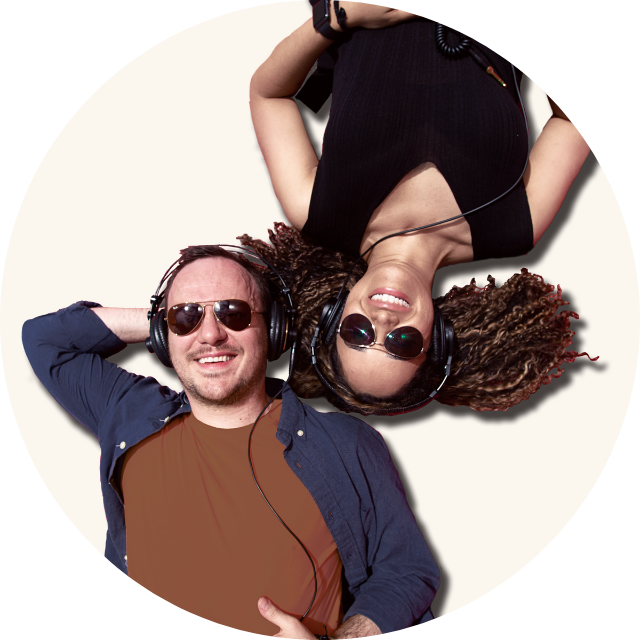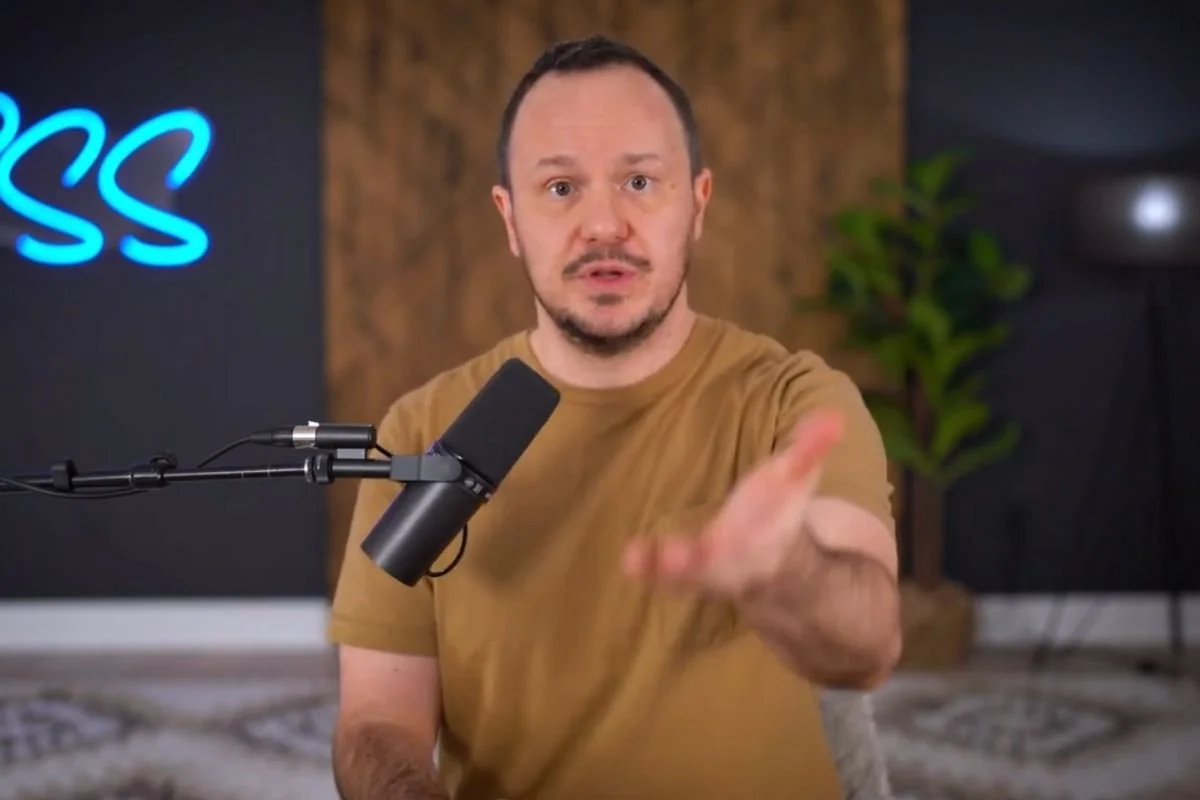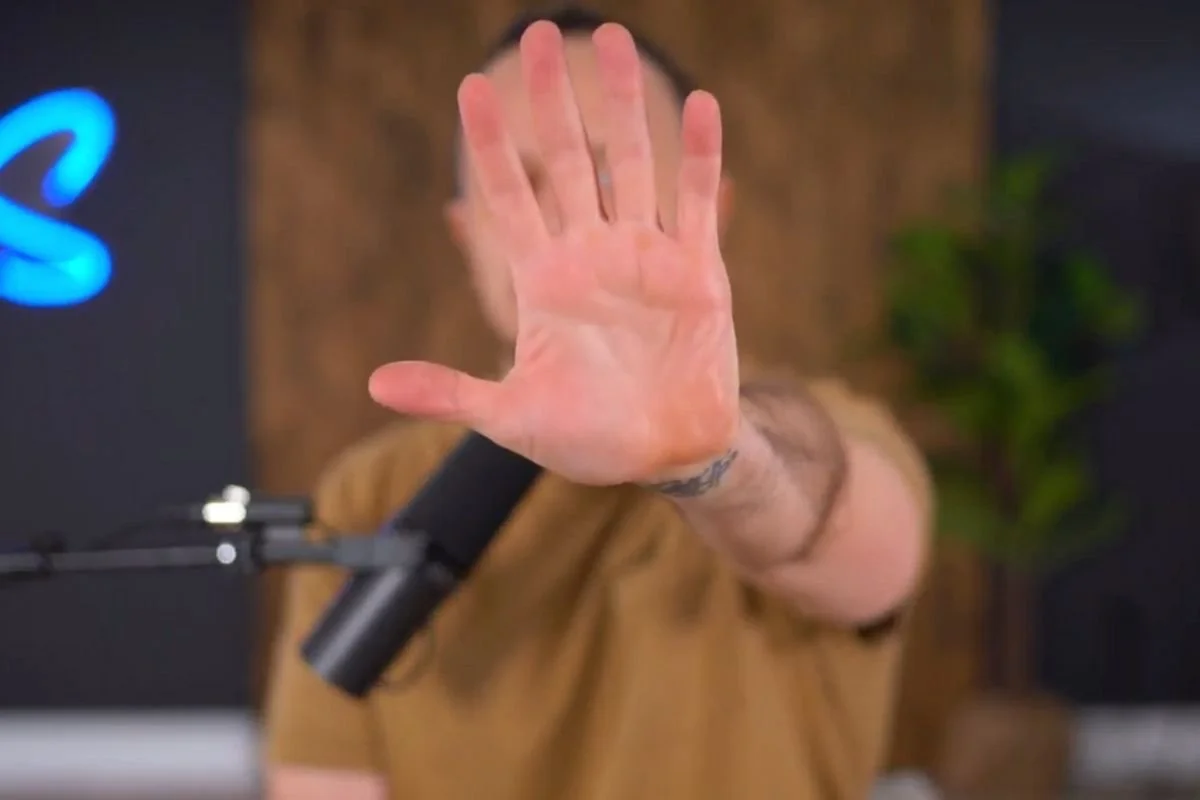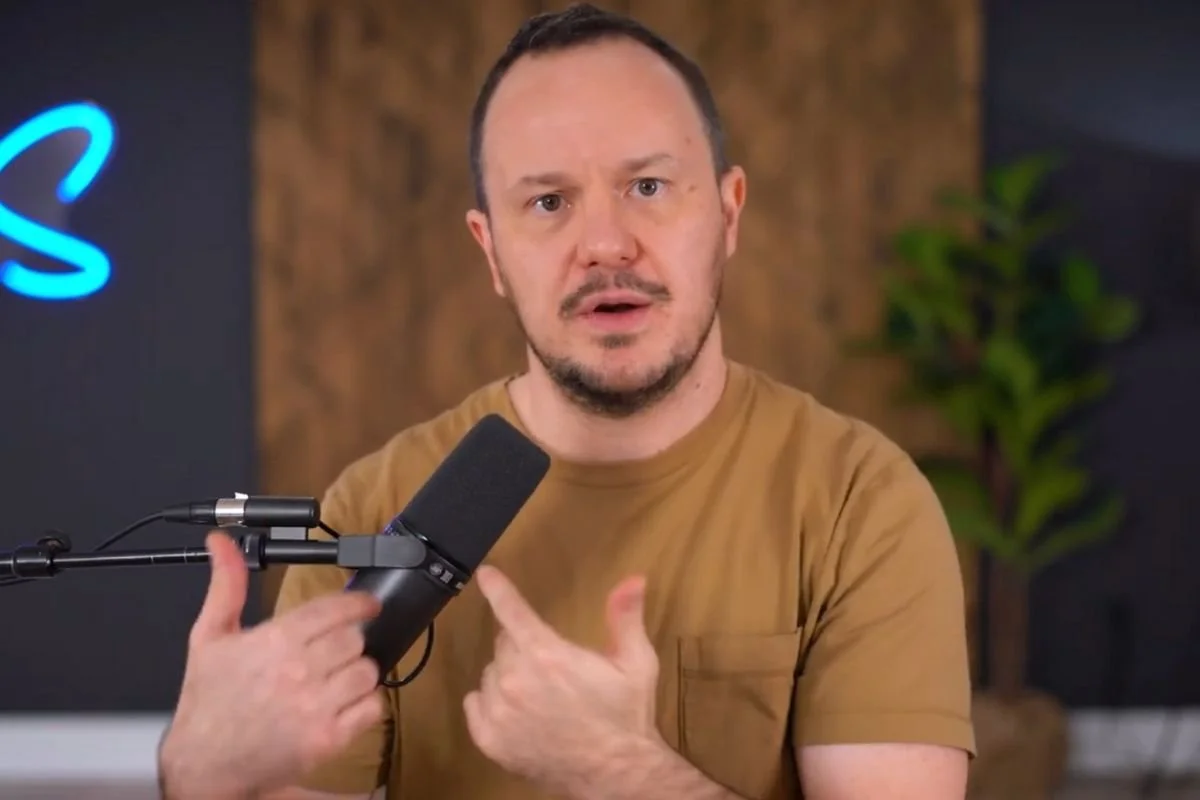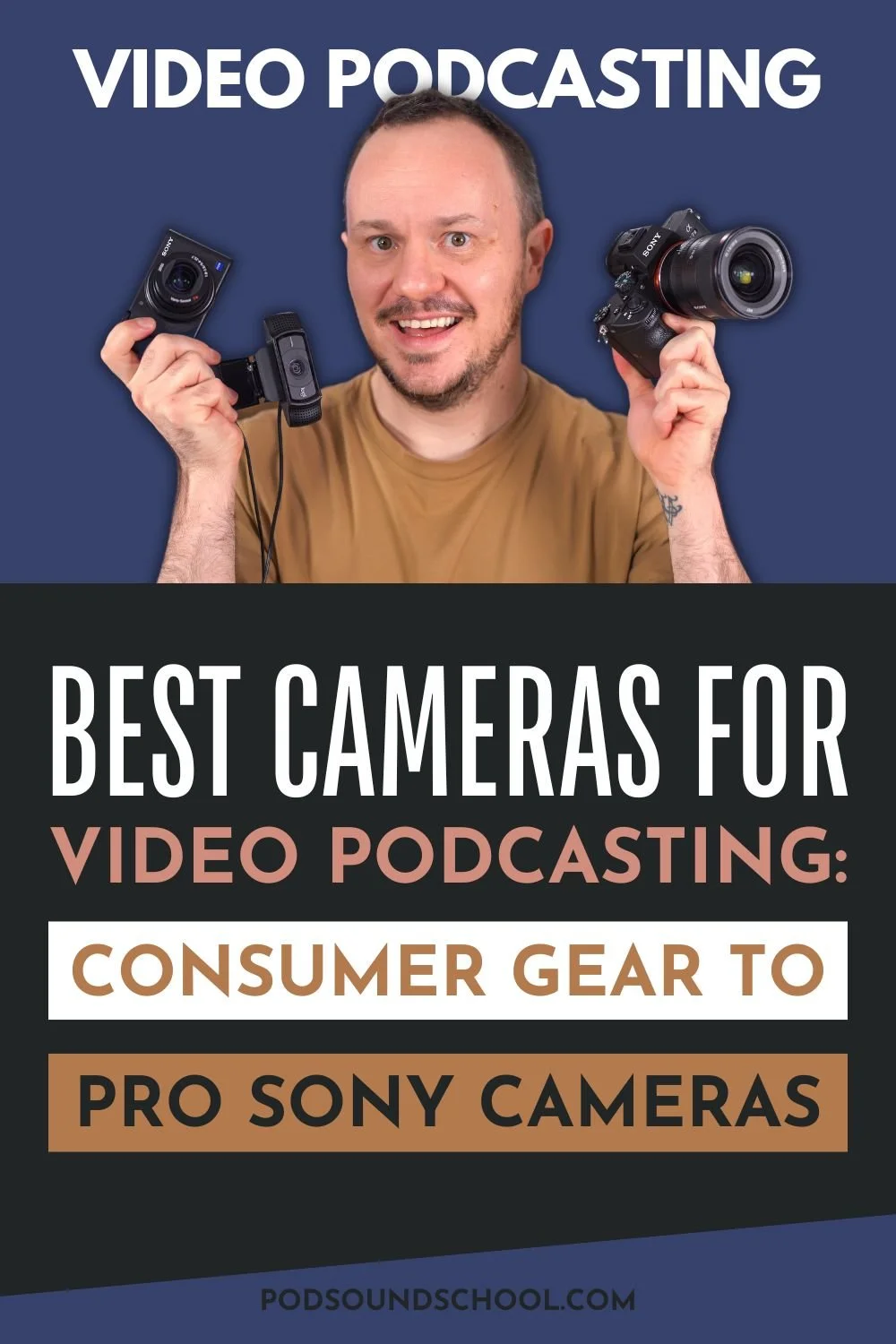Best Cameras for Video Podcasting: From Consumer Gear to Professional Gear
As an Amazon Associate, Pod Sound School earns from qualifying purchases made through the links provided on this website. This means we may receive a small commission at no additional cost to you if you choose to purchase through these links. Your support helps keep the content coming. Thank you!
Choosing the best camera for video podcasting can make all the difference in your content's quality, helping you achieve a professional look without technical frustrations. Whether you're starting out or looking to upgrade your gear, finding the perfect camera that fits your needs and budget is key.
In this guide, we’ll break down Pod Sound School’s top three picks for video podcasting cameras across three categories—consumer, prosumer, and professional. From webcams to high-end gear, you’ll discover the best options to enhance your podcast and improve the quality of your recordings.
By the end, you’ll know exactly which camera setup is right for you, no matter your budget or experience level.
Jump to a specific section:
WATCH OUR RELATED YOUTUBE VIDEO — Best Cameras for Video Podcasting: From Consumer Gear to Professional Gear
Before we start, welcome to the Pod Sound School! I'm Studio Steve, an audio and video producer and instructor in our online coaching programs with about 20 years of experience in professional audio production.
If you’re interested in learning more about how podcasting can help you grow your business, sign up for our mini course Idea to Podcast Simplified for Creators and Professionals.
Pod Sound School’s Top Picks for Video Podcasting Cameras
2 MUST-HAVE CAMERA FEATURES FOR VIDEO PODCASTING
The best cameras for video podcasting are also the best cameras for streaming, and that's because you want a camera with these 2 KEY features:
can connect directly to your computer
does NOT have an auto shutoff feature that will cut you off in the middle of your interview or live stream — which typically happens after 5 minutes of ‘inactivity’
No matter which camera you buy, make sure it has those 2 features. Now let’s get into the picks!
BEST CONSUMER CAMERA: THE EASIEST FOR BEGINNERS
The best consumer-level video podcasting and streaming camera is a webcam.
Webcams are a better option than the built-in cameras on our laptops for 2 reasons:
they capture higher-quality footage than a built-in camera
they aren't built-in to your computer, giving you the flexibility to plug it into your computer and then move it around to create a better-looking shot for your podcast
STANDARD LOGITECH WEBCAM
This Logitech 1080p HD webcam is a great all-around choice and you can get it for about $100 US.
4K LOGITECH WEBCAM
You can also get the 4K version of the Logitech webcam for about $140 US.
WIDE-ANGLE SHOT
Most webcams get a wide-angle shot, which makes it easier to get a nice-looking shot when recording in small spaces.
And if you have a cohost or guest sitting next to you in the same room, it’ll be easier to squeeze you both into one shot with the intention of cropping in on each speaker to create multiple scenes after the fact in editing.
So a webcam really is all you need to get started.
BEST PROSUMER CAMERA: THE PERFECT MIDDLE GROUND
If you want to take it up a notch from a webcam, improve your picture quality, and add to the professionalism of your video podcast, the next stop is a prosumer camera.
The best prosumer-level video podcasting and streaming camera is the Sony ZV-1 camera.
This camera really is everything you need to get going with video podcasting, content creation, YouTube videos, and a lot more.
The Sony ZV-1 goes for about $750 US.
THE SONY ZV-1 HAS THE 2 MUST-HAVE CAMERA FEATURES
☑️ it connects directly to your computer
☑️ it won't automatically shut off when it's connected to your computer
So, it's perfect for live streaming or recording remotely with solutions like SquadCast by descript.
THE SONY ZV-1 LENS
The lens that it comes with the Sony ZV-1 camera is very impressive.
It's a zoom lens that ranges between 24 millimeters and 70 millimeters, which gives you a lot of flexibility to get lots of different types of shots.
If you zoom all the way to that 70-millimeter option, that's where you can get:
cinematic look
more blurred-out background
Of course, you will have to step farther away from the camera.
And conversely, the 24-millimeter option is perfect for that wide-angle shot if:
you need to get more than one person in your shot
or if you're in a small space or need to be very close to the camera
REVERSIBLE FLIP-SCREEN
The other thing that makes the ZV-1 camera so popular with content creators and vloggers is the flip screen that's reversible.
This makes it perfect for solo applications when it's just you running the show because:
You can see what shot you have set up
You can ensure that it is actually recording
You need to be able to monitor what the camera sees when you're creating your videos and your podcast so it's perfect for that.
CAPTURES 4K VIDEO
Another amazing feature of this camera is it captures 4K video, which is really important to get 4K video if you plan on cropping in on your video.
For example, in the case of an in-studio video podcast recorded with two people in the same shot (like a host and a cohost or guest) and you want to create three shots out of one in the edit by cropping in on whoever's speaking (or create an active speaker view type effect) you can do that more easily with 4K footage.
There's so much resolution there that allows you to really zoom in and crop in on your picture without it becoming too pixelated.
As soon as you get down to 1080p, zooming in on your footage is going to become more difficult.
So this really gets you playing around in the professional world.
3 SPECIAL DISCLAIMERS AND WORKAROUNDS FOR THE SONY ZV-1
But it's important to know that there are a few workarounds that you're going to need to use with this camera.
IT AUTO-SHUTS OFF
When you're recording at 4K to the SD card that you'll put into the camera, the camera will shut off at about five minutes, which can be really annoying and not useful at all if you're trying to record a long podcast episode or make a YouTube video.
But there is a setting in the camera. It's the ‘Auto Power OFF Temp.’
When you click into that setting, you'll notice that you have an option for standard or high. If you select high, this will allow the camera to record up to 30 minutes of 4K video onto that SD card.
IT DOESN’T PLUG INTO YOUR COMPUTER
Now, the other thing that's important to know is that you will need an adapter in order to hook this camera up to your computer.
The best adapter for that is the Cam Link 4K.
With this adapter, you'll be able to get the HDMI output of this camera into your computer, no problem. You'll be all set up for video podcasting!
IT’S BATTERY-POWERED
Another big disclaimer about the Sony ZV-1 camera is that it can’t be plugged into a power source, which means it’s battery-powered only.
That can be a big problem when you're streaming or doing long episodes!
The workaround for that is a dummy battery. And yes, that's actually what they call it, a dummy battery.
You can simply remove the battery that comes with the camera and replace it with the dummy battery.
Now, there will be a cable that comes out of the camera.
NOTE: You may have to force it in there and even make some minor adjustments to get it to fit right.
But with the dummy battery and the 4K adapter, you'll have everything you need to video podcast like a beast.
DUMMY BATTERIES FOR DUMMIES
THE 2 DUMBEST THINGS ABOUT DUMMY BATTERIES:
1 — ONE SIZE DOESN’T FIT ALL
Before you hit the buy button, read the fine print to ensure you order the right one for your camera.
Gonine NP-BX1 for ZV-1 — $21.99 US
Gonine NP-FW50 for ZV-E10 — $24.99 US
Gonine NP-FZ100 for A7 III, A7 IV, FX30 — $39.99 US
SmallRig NP-FZ100 for A7 III, A7 IV, FX30 — $49.99 US
2 — REQUIRE SCARY DIY CAMERA MODIFICATIONS
Many cameras require the user to make scary 'modifications' to the battery compartment for it to close properly.
For example, the A7 IV’s battery compartment lid will currently not close with the dummy battery cable sticking out. The camera gives me an error message "Stephen, I can't promise this battery situation is safe” but I haven't dared slice a chunk out of the compartment lid yet, because it's such a nice camera and I don't have the right tool.
Other Common Problems: When using batteries from non-Sony brands, you may get an error message and/or not be able to view the battery’s power level simply because Sony cameras are programmed to work specifically with Sony’s rechargeable batteries.
SONY ZV-E10: BEWARE OF THIS PITFALL
The Sony ZV-E10 ($800 US) is the ZV-1 ($750 US) but with the option of attaching lenses.
The drawback of this camera is the crop sensor.
The crop sensor will zoom in or cut into your frame size meaning if you use a 28mm lens, the focal length will actually appear as a 40mm perspective.
To get around this, many people choose to use the Sigma 16mm lens, which (because of the crop sensor on the ZV-E10) is more of a 24mm perspective.
SONY 28-70mm LENS (our top lens pick for the Sony ZV-E10)
Remember because of the ZV-E10’s crop sensor, the Sony 28-70mm lens will function more like a 40mm to 100mm. So, although you won’t ever be able to capture a true wide-angle shot, the zoom range is perfect for getting cinematic looks and subtly blurry backgrounds.
TOP PROFESSIONAL CAMERA: ULTIMATE CINEMATIC QUALITY
Now, what do you say we move on to the professional level cameras? Our top pick for that is the Sony A7 Mark III.
What makes these cameras so special is that you can attach any number of lenses to the camera. This is why professional photographers and videographers will opt for a nice Sony camera like this.
WHAT MAKES A CAMERA PRO-LEVEL?
The biggest contributing factor that makes the most significant difference between professional video and consumer video is the lens.
It's all about the lenses, especially prime lenses.
Prime lenses have what's called a fixed focal length, which means they're not zoom lenses and they get a superior image quality to zoom lenses.
But these lenses can be very expensive — over a thousand dollars just for one lens!
WHAT IS THE COST OF A PRO-LEVEL CAMERA?
Just the body of a nice DSLR camera like the Sony A7 Mark III can run you $2,000 US.
Then when you add a prime lens to the shopping cart, you're getting into the $3,000 US range.
OUR GO-TO PRO-LEVEL LENS
Our go-to lens for the Sony A7 Mark III is the G Series FE 35mm F1.4 lens which goes for about $1,400 US.
Lenses like this allow you to capture a beautiful cinematic picture quality with a LOT of details and a blurred-out background.
GETTING A CAMERA WITH INTELLIGENT AUTOFOCUS IS KEY
This lens is incredible, not just because of the clear, amazing picture quality that it gets, but also because it has really intelligent and fast autofocus, which is very important, especially when we're running the show solo.
Sony cameras, allow you to select a small area on your screen that you want to be in focus — the camera will then prioritize keeping that area in focus.
In the screenshot of my video here, I have my face selected.
To demonstrate how fast this autofocus is for you, I can hold my hand in front of my face, and you can see that it will quickly compensate and focus on my hand.
And notice that it never focuses on the microphone or my hands. It's keeping my face in focus for me. Really important when you're running the show solo.
And of course, these cameras capture great 4K quality.
SONY DSLR CAMERA SHUTOFF TIME
Sony cameras have a half-hour shutoff time with the 4K video onto the SD card.
HOW TO PLUG A SONY DSLR CAMERA INTO YOUR COMPUTER
They work and operate with the same Cam Link 4K adapter mentioned earlier.
HOW TO MANAGE THE POWER
You will need to purchase a dummy battery for these Sony DSLR cameras too.
IF YOU’RE A SOLO PODCASTER…
Finally, something to keep in mind with this style of DSLR camera is that the flip screen LED monitor doesn't flip around when the camera's facing you.
This means you may need to purchase an external monitor.
Now if you're always going to have your camera plugged into your computer using a streaming service or a remote recording solution like Squadcast FM or Riverside FM, you'll be able to monitor your camera on the computer.
You can use your computer screen as the monitor.
But if you're shooting YouTube videos, you're reading from a teleprompter, you're creating content that way, you may need to purchase an external monitor.
It doesn't have to be anything fancy. I really love and recommend the FreeWorld 4K monitor.
SONY A7 IV vs. SONY A7 III
The Sony A7 IV camera has a 33MP sensor, an upgrade from the 24.2MP sensor on the A7 III, offering better resolution and detail.
Both cameras use back-illuminated sensors for improved low-light performance.
In terms of video, the A7 IV supports 4K recording at up to 60 fps in Super35 mode, compared to the A7 III's 30 fps limit.
The A7 IV can record 10-bit 4:2:2 internally, while the A7 III is limited to 8-bit 4:2:0.
Additionally, the A7 IV introduces S-Cinetone, a color profile aimed at achieving more cinematic visuals, which the A7 III lacks.
Overall, the A7 IV offers better image quality and advanced video recording options.
SONY FX30 vs. SONY A7 IV
Price Comparison
The FX30 is priced at around $1,800 (or $2,200 with the top handle), while the A7 IV is more expensive at $2,500.
Photography vs. Video Capabilities
The FX30 is video-focused with a 26 MP sensor but lacks a mechanical shutter, which can cause banding in photos. The A7 IV excels in photography with its 33 MP full-frame sensor and mechanical shutter.
Rolling Shutter and Frame Rates
The FX30 performs better with rolling shutter and offers 4K at 120 fps, though with a significant crop. The A7 IV can only do 4K at 60 fps, also with a crop.
Overheating and Build
The FX30 has a built-in fan, making it less prone to overheating, while the A7 IV has overheating issues, but this can be mitigated by adjusting settings.
Video Features of FX30
The FX30 offers advanced video features like raw recording, Cine EI mode (adjust the brightness of a movie), and XLR input through the top handle, making it more suited for video, while the A7 IV is better for those needing both strong video and photo capabilities.
TOP AFFORDABLE CINEMATIC CAMERA FOR VIDEO PODCASTING
SONY FX30 CAMERA with XLR HANDLE
If you’re looking for the ultimate cinematic look without the Hollywood price tag, go with the FX30.
WHAT’S SO SPECIAL ABOUT THE FX30?
The Sony FX30 is an ideal choice for video podcasters, YouTubers, and content creators looking to capture high-quality, cinematic visuals.
While it isn’t on Netflix’s approved camera list due to factors like its Super 35mm sensor size, codec limitations, and dynamic range, the FX30 excels in offering cinema-grade features at an affordable price.
Its smaller sensor still delivers impressive results, and its downsampled 4K footage maintains high visual standards for most content creation needs.
WHAT THE HECK IS AN XLR HANDLE?!?
An XLR handle is an accessory that attaches securely to the top of your camera and provides professional-grade audio input options.
For video podcasters, this means you can easily connect high-quality microphones that use XLR cables—typically used in professional settings for clearer, more reliable sound.
The handle also makes it easier to carry your camera and helps with getting certain types of shots, like low angles.
It features controls for adjusting your microphone settings directly on the handle, allowing you to capture great audio right through your camera without needing extra audio gear or complicated setups.
But perhaps most importantly, when podcasting on the go, you don't need a laptop or portable audio recorder, and you won’t need to sync the audio with the video in post-production.
Even if you’re not traveling, the handle can make your video podcasting setup much simpler while ensuring your audio sounds professional.
Devices That Can Be Plugged into a Sony XLR Handle:
XLR Microphones (e.g., dynamic mics like the Shure SM7B or condenser mics)
Quarter-inch plugs (e.g., instruments or other audio devices using 1/4" TRS connectors)
3.5mm microphones (e.g., lavalier mics, wireless systems like Rode Wireless Go)
Wireless mic systems (e.g., two-channel wireless lav systems like the DJI Mic or Rode Wireless Go 2)
Other audio devices with XLR or 3.5mm connections (e.g., audio mixers, external recorders)
Main Features of the XLR Handle:
Built-in microphone holder: Holds and secures a shotgun microphone.
Two XLR inputs: Allows for professional XLR microphones or other audio devices.
Supports phantom power: Provides 48V power for condenser microphones.
Combo jacks: Can accept both XLR and quarter-inch plugs in the same ports.
Third audio input: A 3.5mm stereo jack for connecting additional microphones.
Four-channel audio: Supports recording from up to four microphones or audio sources at once.
Customizable gain controls: Offers manual or automatic gain adjustment for each input.
Low-cut filter: Reduces low-frequency noise with 100Hz or 300Hz settings.
Manual/Auto audio control: Offers full control over audio levels or automatic adjustment.
On/off switch for audio control: Lets you disable the audio input when not in use.
Multiple mounting points: Includes quarter 20 spots and cold shoes for attaching accessories.
Secure attachment: Bolts directly to the camera for stability.
WHY SONY OVER CANON?
Now finally, you may be asking, why Sony over Canon?
The Canon M50 is a similar price to the Sony ZV-1 so why would you choose a Sony ZV-1 with a fixed lens over a Canon M50 with a detachable lens?
The main reason is that the Canon M50 has an automatic shut-off feature, and the only way to disable it is by hacking the camera's firmware and using complicated software on your computer.
Most of us don't have the technical know how or the patience to make that happen, which is a deal breaker for Canon cameras when it comes to video podcasting.
Sad — I know because I've long been a Canon guy — but with video podcasting, Sony is the clear winner.
WATCH OUR RELATED YOUTUBE VIDEO:
Best Cameras for Video Podcasting: From Consumer Gear to Professional Gear
FINAL THOUGHTS
Choosing the right camera for your video podcast depends on your goals, budget, and desired level of professionalism.
Whether you’re just getting started with a simple webcam, leveling up with the versatile Sony ZV-1, or going all-in with a professional setup like the Sony A7 Mark III, the key is to find the gear that best fits your needs and helps you create high-quality content without technical headaches.
By understanding the unique features and limitations of each option, you can make an informed decision and set yourself up for success in delivering a visually engaging, polished video podcast.
My overall pick is the Sony ZV-1. This is just such a great camera for so many reasons.
PIN THIS POST TO READ LATER
LEARN MORE ABOUT VIDEO PODCASTING AND PODCASTING GEAR
Best Sony Camera for Video Podcasting: How to Create a Cinematic Look
This is How I Choose the Right Podcast Microphone for Audio-Only and Video Podcasting
Easy Cinematic Lighting Setup for Video Podcasts (With Just 3 Lights!)
2-Person Video Podcast and Live Stream Setup - Ultimate Guide for BEGINNERS
Multicam 2-Person Video Podcast and Live Streaming Setup Gear Guide
3 Smart and Simple Hacks to Create Cinematic B-roll and Behind-the-Scenes Videos
RECOMMENDED YOUTUBE VIDEOS
Best Camera for Video Podcasting [Cinematic Look]
This Sony camera and lens combo will help you achieve that high-quality, cinematic, blurred background look that makes you look like a true podcast star. 👇
Video Podcasting: From Concept to Studio Setup
Thinking about starting a video podcast? This is everything you need to know so you don’t waste money on unnecessary gear. Download this FREE Workbook to follow along with the video. 👇
FREE PODCASTING RESOURCES
Get Even More Video and Audio Podcasting Tips and Gear Picks ➔ Subscribe to Pod Sound School’s FREE Creator Hub Newsletter
Go from Podcast Idea to Podcast Planning & Execution ➔ Take this FREE Mini-Course for Creators and Professionals
Build Your Video Podcast (Production, Equipment, Studio Setup, Training, Distribution) ➔ Grab this FREE Step-By-Step Workbook and Watch this Video
See If You Have What It Takes to Become a Professional Podcast Editor ➔ Try Podcast Editing in This FREE Mini-Course for Aspiring Podcast Editors
WORK WITH US / TAKE A COURSE
Launch Or Upgrade Your Video Podcast ➔ Work 1-On-1 With Us
Showcase Your Brand, Products, or Services ➔ Done-For-You Video Ads and Sponsored Videos
Launch Your Video Podcast in 6 Weeks ➔ Done-With-You Group Coaching Program
Become a Video Podcast Editor in 12 Weeks ➔ LIVE Group Training Program
Why Work with Pod Sound School? ➔ Read More About Us // View Our Portfolio and Media Kit // Binge Watch Our YouTube Channel
